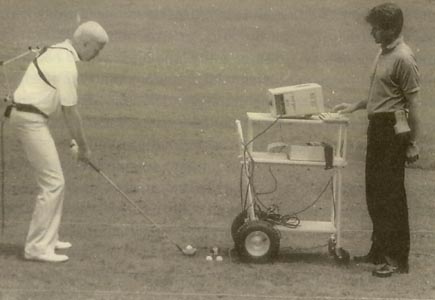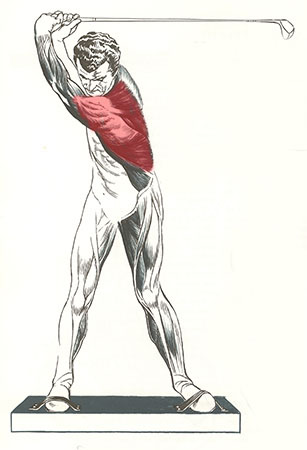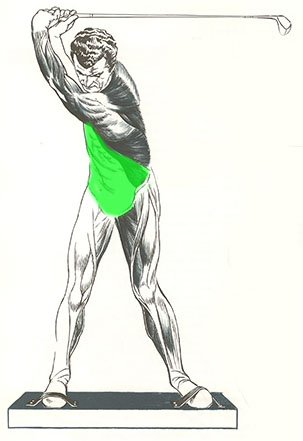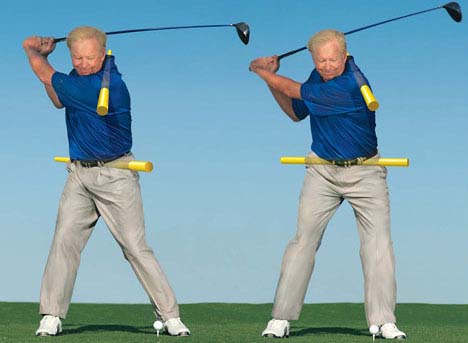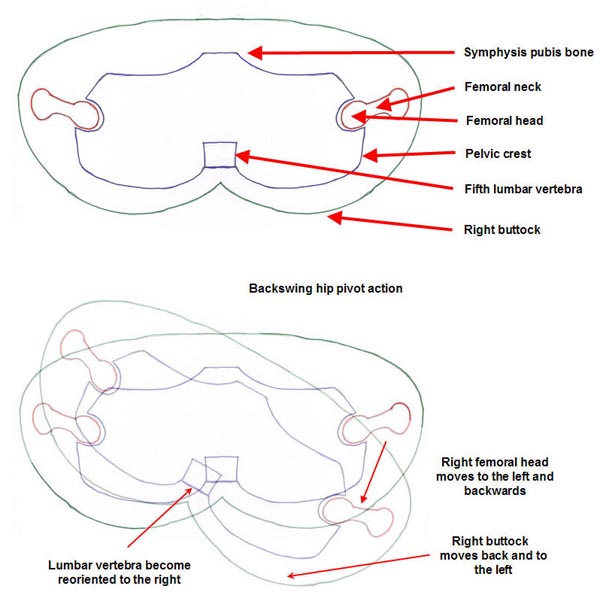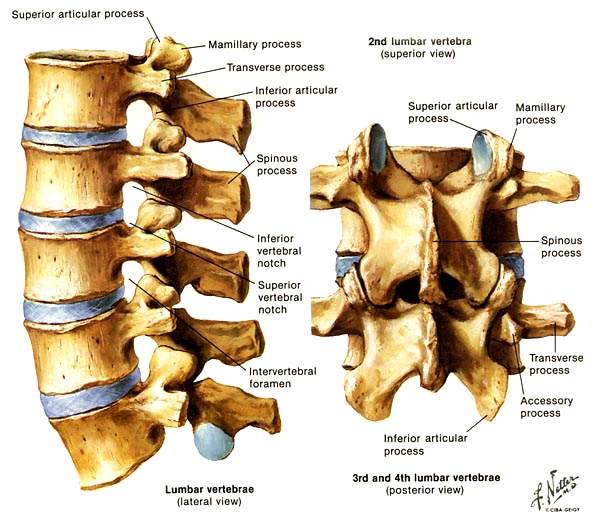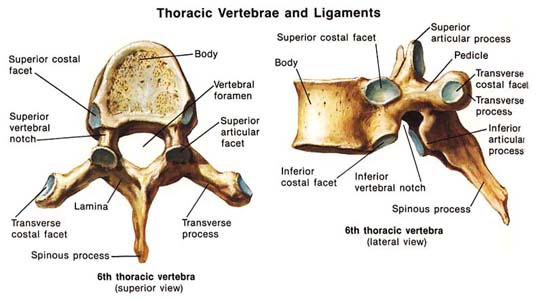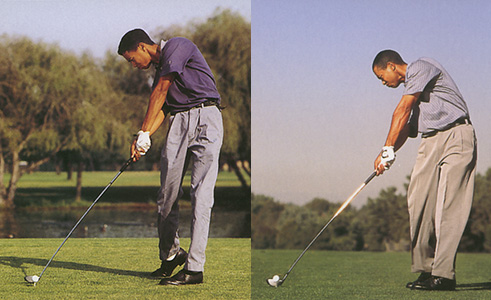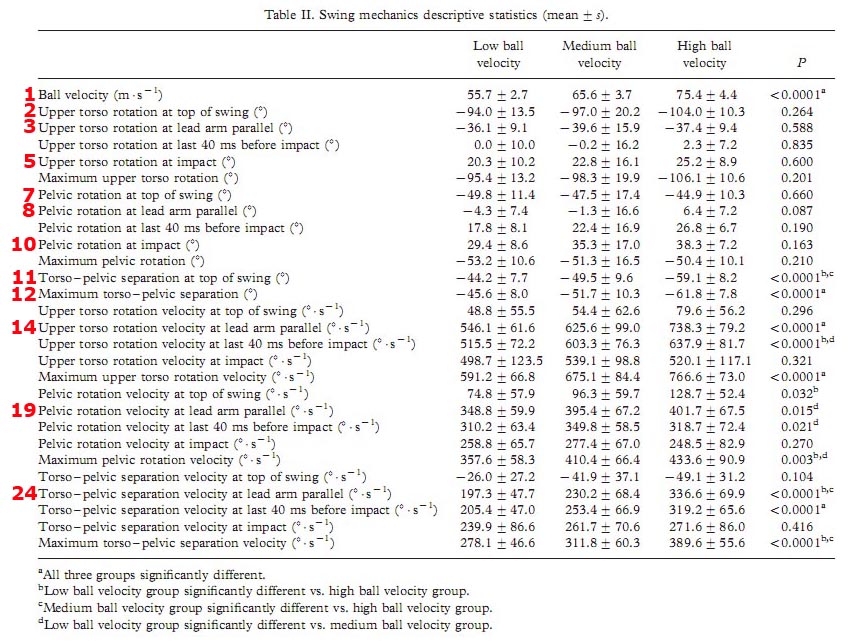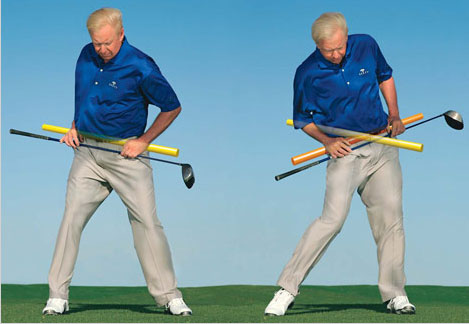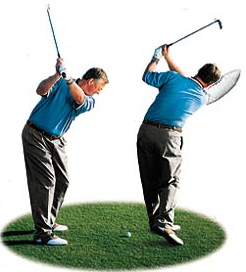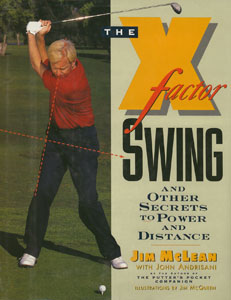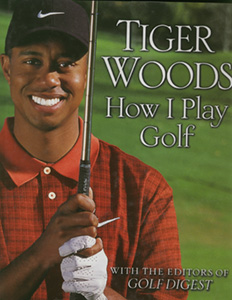Jim McLean's Triple-X Factor - A Critical Review
Click here to go back to the index page.
Introduction:
In this review paper, I will be critically reviewing Jim McLeans' triple-X factor concept, which is the topic of an article that he wrote for the January 2008 issue of Golf Digest magazine [1]. The triple-X factor idea consists of three separate concepts - the X-factor stretch, the hip rise and the head swivel. The major idea that JimMcLean is famous for is the X-factor, which he first described in an article in the December 1992 issue of Golf Magazine [2]. Basically, Jim McLean recommended that golfers should attain a certain differential in the degree of shoulder turn versus pelvis turn (certain degree of torso pelvic separation) during the backswing, and he believed that if a golfer optimised the degree of torso-pelvic separation at the top of the backswing, that it would enable a golfer to maximize swing power. In a certain sense, his original X-factor concept can be thought of as being a static X-factor, because it represented the body's position at the end of the backswing, and he believed that if the upper body was correctly coiled against the resistance of the lower body at the end-backswing position, that a golfer was storing swing power energy that could be unleashed during the downswing. In his more recent GD article, Jim McLean is introducing the idea of a dynamic X-factor, where the degree of torso-pelvic separation is increased at the start of the downswing as a result of the lower body moving before the upper body. If the lower body moves before the upper body in the downswing, then it would increase the degree of torso-pelvic separation, and it is therefore easy to understand why Jim McLean would call this dynamically-activated increase in torso-pelvic separation the X-factor stretch.
I will be describing the three component parts of the triple-X factor concept separately and most of this review paper's contents will be devoted to the topic of the X-factor (both the static X-factor and the dynamic X-factor). I will start off by describing the evolution of the X-factor concept, as described by Jim McLean in his book on the X-factor [3], so that a beginner golfer can better understand its historical significance and its present-day applicability. After describing the X-factor concept, I will then critically review the biomechanical validity of its core fundamentals from a personal perspective. Beginner golfers, who know me from my website's other critical review papers, will expect an in-depth review that is very scholarly and very probing, and I don't think that I will disappoint that small subset of beginner golfers who frequently visit my website because they are eager to maximize their understanding of the biomechanics of the golf swing. I have given this subject a great deal of thought and I will be introducing many new ideas that should intrigue an open-minded beginner golfer who is willing to entertain new ways of thinking about the biomechanics of the golf swing. As always, I expect my website visitors to be creatively sceptical of my personal opinions, and to not accept, or reject, my opinions without a great deal of independent thought. Whether a beginner golfer finds my opinions rational/logical (or not), this review paper will provide him with a great deal of controversial thought-material that he will need to digest.
The X-factor Stretch
In his book [3], Jim McLean stated that at the time he developed his X-factor concept (early 1990's), that the prevalent golf instructional approach to the golf swing was premised on the teaching idea that "to generate maximum power, turn your hips and shoulders to the maximum." In other words, a golfer, who wanted to maximize swing power, was encouraged to freely turn the hips and to turn both the shoulders and hips to the maximum possible degree. Jim McLean's X-factor concept is basically a rejection of that conceptual idea, and he believed that one needs to retrict the hip turn so that one can coil the upper body against the resistance of the lower body. How did Jim McLean develop his X-factor idea? In his book [3], Jim McLean stated he based his idea on research findings derived from a SportSense Motion Trainer (SMT) developed by Mike McTeigue. Here is a photo of the machine in operation - with Jim McLean as the guinea pig and Mike McTeigue at the controls. The SMT machine is capable of measuring the degree of shoulder and pelvis rotation at different points in the swing.
SportsSense Motion Trainer - from reference number [3]
Jim McLean derived a great deal of SMT data as a result of using the SMT machine on tour players, and he discovered that long hitters (power hitters) had a greater differential - rotating the shoulders much more than the hips.Here is a table from Jim McLean's Golf Magazine article [2].
Five Long Hitters
Player Shoulder turn (degrees) Hip turn (degrees) Gap Gap as % of shoulder turn Distance ranking
John Daly 114 66 48 42 1 Tom Purtzer 88 49 39 44 4 Tommy Armour III 69 37 32 46 22 Jay Don Blake 100 59 41 41 29 Mark Hayes 71 37 34 48 37 Average 88 50 38 43 19 Five Short Hitters
Lennie Clements 86 63 23 27 141 Lance Ten Broeck 83 59 24 29 148 Tom Byrum 89 70 19 21 158 Peter Persons 100 71 29 29 175 Mike Reid 88 62 26 30 184 Average 89 65 24 27 161
It can be seen that long hitters, on average, didn't have a greater degree of shoulder rotation than short hitters, and that the major difference between the two groups is due to the fact that long hitters had a more restricted hip turn (50 degrees versus 65 degrees). It can be seen that the gap (magnitude of torso-pelvic separation) can be expressed as a % of the shoulder turn, and that long hitters had a larger "gap as % of the shoulder turn" value - 43% versus 27%. Jim McLean thought that this was the source of their greater swing power. It is interesting that Jim McLean didn't offer a biomechanical reason why increased torso-pelvic separation should increase swing power in his article. He vaguely wrote about loading/coiling the upper body against the resistance of the lower body, but he didn't elaborate any further on this issue in his landmark article and book. So, how does increased torso-pelvic separation during the backswing increase swing power?Although I have never personally read a biomechanical explanatory comment by Jim McLean as to why increased torso-pelvic separation can potentially increase swing power, I have read many comments by golfers who interpret his research findings in the following manner. Some golfers believe that if one turns the upper torso more than the lower torso, that one is stretch-coiling the upper torso against the resistance of the lower torso, which has a more restricted turn. The analogy they use is of a wire watch spring which is coiled up. They conceive of the upper torso coiling up during the backswing (like coiling-up a wire watch spring) and passively uncoiling during the downswing. In other words, they think of the upper body as having elastic properties, and they think that the upper body can store energy elastically during the backswing, and release this energy elastically/passively during the downswing - and that this "elastic energy" can supplement the energy generated by active muscle contraction during the downswing phase of the golf swing. However, there is no anatomical equivalent of a "coil spring" in the human body and there is no research evidence that demonstrates that body structures like torso muscles/tendons can store significant amounts of energy elastically when stretched during the backswing and then release significant amounts of elastic energy passively during the downswing. I think that the most rational explanation for the increased swing power relates to the fact that certain torso muscles are eccentrically loaded if torso-pelvic separation is maximized during the backswing. Consider the following diagram.
Photo-diagram adapted from reference number [4]
When a golfer turns the upper torso much more than the lower torso, he is essentially stretching certain torso muscles, especially torso muscles on the left side of the torso (depicted in red in the above diagram). Those stretched torso muscles do not increase swing power during the downswing secondary to a passive elastic recoil phenomenon, but simply due to the phenomenon of stretch-induced enhancement of muscle contraction. It's a simple physiological fact that a stretched muscle (if not over-stretched beyond its limit of contractile-effectivity) can contract further (more) during the same period of time as a muscle that is less stretched. So, if a muscle normally stretches by an amount of "y" and you increase the stretch by an amount of "z", then that muscle is stretched by an amount of "y + z". If the stretched muscle contracts fully, then it is contracting a greater amount during its contractile phase, and it can therefore actively produce a greater amount of energy per unit time. In other words, the increased swing power is most likely due to increased active muscle contractile power of the eccentrically loaded torso muscles during the downswing phase of the golf swing, and it is not due to passive elastic forces that are potentially stored up during the backswing.
From my perspective, the idea that increased torso-pelvic separation during the backswing can increase swing power is not really controversial - even if golfers argue about the precise biomechanical-etiological explanation that best explains the cause of the increased swing power. The second question then becomes - can a further increase in torso-pelvic separation at the start of the downswing independently increase swing power (independent of the static X-factor)? I find the idea that increased torso-pelvic separation at the start of the downswing (dynamic X-factor or X-factor stretch) can independently increase swing power very problematic.
There is no doubt that certain golfers can increase torso-pelvic separation at the start of the downswing. Jim McLean stated in his article [1] that certain tour golfers can increase their torso-pelvic separation by an average amount of 17 degrees, and one can readily see that phenomenon in Tiger Woods' swing. Here is a good quality slo-mo SwingVision video of Tiger Woods driver swing.
http://www.youtube.com/watch?v=DEdWy9gP-Zo&mode=related&search=
Note that Tiger Woods has a significant amount of torso-pelvic separation at the end-backswing position, and that he seems to restrict his hip turn to about 35 degrees while rotating his shoulders by about 100 degrees. That creates a static X-factor differential of about 65 degrees - which is huge! If Tiger Woods can increase his torso-pelvic separation by another 17 degrees at the start of his downswing, can that increase swing power, and what's the biomechanical explanation for the increased swing power? Jim McLean uses the term X-factor stretch to denote the dynamic X-factor. But what part of the torso is becoming increasingly stretched during the downswing transition phase of the golf swing - when the hips turn before the maximally-rotated shoulders? It cannot be those torso muscles on the left side of the body (depicted in red in the above diagram) because they were maximally stretched during the backswing phase of the golf swing, and those particular muscle groups would also not be stretched more if the pelvis rotates forwards. Therefore, it must be torso muscles on the right side of the body. There are no torso muscles on the front side of the right chest wall that can be significantly stretched, and therefore it must be the abdominal wall muscles on the right side of the body that get increasingly stretched when the pelvis rotates forwards.
Photo-diagram adapted from reference number [4]
If the pelvis rotates before the upper torso during the transition phase of the golf swing, then the abdominal wall muscles (depicted in green) are stretched, and they can therefore potentially contract a greater amount/distance per unit time when those abdominal wall muscles eventually become active during the early downswing. In other words, the increased active muscle power of those stretched abdominal wall muscles could potentially increase the uncoiling of the upper torso and generate faster upper torso rotational speeds. This biomechanical phenomenon is not due to the storing up of elastic power in torso muscles, so that the elastic power can be passively released at a later stage. Rather, it is due to stretch-induced enhancement of muscle contraction due to the eccentric loading of certain lower-mid torso muscles - when the hips move before the shoulders.
In his article [1] Jim McLean wrote-: "To maximize your stretch, learn to start the downswing with your lower body. Place your left hand on your left-front pocket and simulate a backswing with your right arm. Then shift your hips towards the target, feeling your left-front pocket move forward before you start the your right arm down. That's the X-factor stretch - the primary reason an average-sized tour player can drive the ball so far." Jim McLean is seemingly implying that the average golfer should increase his torso-pelvic separation at the start of the downswing, by rotating the hips towards the target while keeping the shoulders back - as demonstrated in the following photo.
Jim McLean demonstrating the X-factor stretch - from reference number [1]
Note that Jim McLean has rotated his hips to a near-square position at the start of the downswing, while keeping his shoulders back (non-rotated). Is it biomechanically possible to keep the shoulders back while rotating the pelvis forward? I believe that it is only biomechanically possible if one has not maximized the static X-factor at the end-backswing position. Consider a simple experiment. Stand at address and then perform a backswing motion and deliberately restrict your hip turn to about 40-50 degrees. Then maximise your shoulder turn to the greatest possible degree. Let's presume that you can turn your shoulders to 100 degrees with the hips turned to 50 degrees. Then get a friend to place his hand on your right shoulder to prevent you moving your right shoulder forward, and try to rotate your pelvis forward in order to further increase your degree of torso-pelvic separation. You will discover that you cannot rotate your pelvis forward. Then repeat the experiment, but turn your shoulders 20 degrees less than your maximum possible shoulder turn (eg. 80 degrees instead of 100 degrees). Then, you will be able to turn your pelvis forward by about 20 degrees at the start of the downswing before the shoulders feel strongly impelled to rotate forwards in concert with the lower body. Why? The reason is that you have a certain amount of "slack" in your spine when you have an incomplete shoulder turn, while you have no spinal "slack" when you have a complete/maximized shoulder turn. In other words, I believe that if a golfer can significantly increase his degree of torso-pelvic separation at the start of the downswing, that it means that he hasn't maximised his potential static X-factor during the backswing, and that he hasn't torqued his thoracic spine to the maximum possible degree during the backswing. No golf teacher discusses the role of the spine in the X-factor concept and I believe that it plays a key role in allowing rotational movement of the lower torso to be transmitted to the upper torso, so that the upper torso and lower torso can act in a time-synchronised, coordinated manner at the start of the downswing. Consider some pertinent anatomical facts regarding the human spine.When one performs a backswing pivot action correctly, the right femoral head moves backwards and leftwards, and that causes the right pelvis to move in the same direction - because the right pelvis has to move with the right femoral head due to the snug cup-shaped anatomical nature of the hip joint. This pelvic movement is depicted in the following diagram.
Movement of the pelvis and lumbar spine in the backswing
Note that the rotational movement of the pelvis during the backswing hip pivot action causes the 5th lumbar vertebra (lowest lumbar vertebra which is rigidly attached to the pelvic sacrum) to move leftwards, but to also change its face-orientation so that it faces towards the right. If the pelvis rotates about 50 degrees during the backswing pivot action, then the 5th lumbar vertebra will also face 50 degrees to the right at the end-backswing position. Consider the anatomical features of the lumbar vertebra.
Lumbar vertebra - from reference number [5]
There are 5 lumbar vertebra and each lumbar vertebra articulates with the adjacent vertebra via a facet joint. The superior articular process of the lower lumbar vertebra abuts the inferior articular process of the adjacent lumbar vertebra (just above) at the facet joint. Note the vertically-oriented cup-shaped appearance of the facet articulation joint, and note how the bony structure of the articular processes only allows the lumbar spine to move in a sagittal (vertical) plane, thus allowing for lumbar flexion and lumbar extension. The lumbar spine is incapable of lateral flexion or rotation. Therefore, if the 5th lumbar vertbra is oriented 50 degrees to the right at the end-backswing position, then the entire lumbar spine will be oriented 50 degrees to the right.The only part of the human spine (below the level of the cervical vertebra) that is capable of some rotary movement is the thoracic spine. Consider the anatomy of the thoracic spine.
Thoracic vertebra - from reference number [6]
Note the shape of the facet articulation joints of the thoracic vertebra - they are like roof shingles. This bony structural arrangement allows each thoracic vertebra to slide a little with respect to the adjacent thoracic vertebra. The potential amount of lateral side-to-side slide is markedly limited by the presence of numerous ligaments and short muscles that tether the thoracic vertebra to each other and to adjacent ribs. Each thoracic vertbra can therefore only slide about 2-3mm laterally, and that allows each thoracic vertebra to have a rotational capacity of about 2-4 degrees. Because the thoracic spine consists of 12 vertebra, the rotational capacity of the entire thoracic spine is limited to about 24-48 degrees (on average). This anatomical structural limitation explains why most golfers, who rotate their pelvis (and lumbar spine) 50 degrees, can only achieve an upper body (shoulder) rotation of 74-98 degrees. Golfers, who are more flexible, can achieve a greater degree of thoracic spine rotation than those theoretical "average" values, and they may potentially have an additional 10-15 degrees of upper torso rotational capacity at hand. Tiger Woods is exceptionally flexible and he can achieve near-superhuman amounts of spinal rotation, and that fact allows him to achieve a static torso-pelvic separation value of approximately 65 degrees at the end-backswing position, and an additional 10-15 degrees of dynamic torso-pelvic separation at the start of the downswing. This explains why Tiger Woods can turn his hips at the start of the downswing while keeping his shoulders back - because he has about 10-15 degrees of spinal "slack" at the end-backswing position, despite a huge static X-factor differential of approximately 65 degrees at the end-backswing position. Is this remarkable anatomical capacity advantageous to Tiger Woods. Not necessarily! Consider the advantages and disadvantages.If Tiger Woods can increase his torso-pelvic separation at the start of the downswing by turning his hips while keeping his shoulders back (thus creating a X-factor stretch of 10-20 degrees), it can potentially increase his capacity to eventually rotate his upper torso at a faster speed a fraction of second later in the downswing - by stretching his right abdominal wall muscles. However, there is a significant downside to this increased capacity to rapidly accelerate the hips at the start of the downswing while keeping the shoulders back - it allows the lower body to more easily outrace the upper body during the downswing. This problem has plagued Tiger Woods throughout his golfing career. Consider this comparison photo of Tiger Woods at impact - when aged 16 years and 24 years.
Tiger Woods at impact - from reference number [7]
Note that Tiger Woods' pelvis is nearly 90 degrees open to the target at impact, and that his right heel is raised off the ground - when he was 16 years old. By comparison, when Tiger Woods was 24 years old, he had learnt how to prevent his lower body outracing his upper body and his pelvis is only about 50 degrees open at impact. Even today (2007), Tiger Woods is wrestling with this hips-outracing-shoulders problem and he is always trying to slow his pelvis down during the downswing, so that he has better coordination between his upper and lower body movements. I recently read that Tiger Woods is consciously attempting to keep his right heel down for longer during the downswing - and this conscious thought-move presumably acts like a "governor" limiting the speed at which his pelvis rotates open during the downswing.Beginner golfers need to understand that the hips should not outrace the shoulders during the downswing, and that the shoulders should nearly catch up to the hips my impact. For example, consider a golfer who has a backswing hip turn of 50 degrees and a backswing shoulder turn of 100 degrees, creating a static torso-pelvic separation value of 50 degrees at the end-backswing position. By impact, a good golfer (on average) will have his hips open by about 40 degrees and the shoulders open by about 20 degrees. That means that during the downswing the shoulders have to rotate 120 degrees while the hips only have to turn 90 degrees. In other words, the shoulders have to rotate more than the hips during the downswing, and they must therefore rotate faster to nearly catch up to the hips by impact. In fact, if one studies a high speed swing video of a tour-quality golfer on a frame-by-frame basis using a swing analyser program, one will note that the shoulder-pelvis turn angle difference (degree of torso-pelvic separation) often diminishes during the early downswing (defined as the time period from the end-backswing position to the lead arm parallel position).
Here is an example of that type of video analysis.
Swing video of one of Slicefixer's students (Slicefixer = Internet name of a reknown Texas golf instructor) - from reference number [8]
Note that the degree of torso-pelvic separation is 48 degrees at the end-backswing position. Note that the degree of torso-pelvic separation steadily diminishes during the early downswing, and that it is only 37 degrees when the lead arm is parallel to the ground (end of the early downswing). In other words, the shoulders are actually rotating faster than the hips during the early downswing. Many beginner golfers are taught that one should hold the right shoulder back at the start of the downswing while they start the downswing with a lower body shift-rotation movement. I think that it is mistake to hold the right shoulder back, and I believe that the right shoulder should move forward as soon as any spinal "slack" is taken up. In other words, I agree that it is very important that a beginner golfer should be taught to start the downswing with a lower body shift-rotation move, so that the downswing starts from the bottom-up (lower body moving first before the upper body secondly moves). However, a beginner golfer shouldn't artificially/unnaturally hold the right shoulder back, and he should allow the shoulders to turn as soon as all spinal "slack" is taken up. If a beginner golfer maximises his static X-factor (maximises his static torso-pelvic separation by maximising the rotary torquing of his thoracic spine during the backswing), then he will only be able to increase his torso-pelvic separation by about 5 degrees in the early downswing (creating an X-factor stretch of about 5 degrees). I think that if a beginner golfer minimizes the spinal "slack" to about 5 degrees by maximizing his shoulder turn during the backswing, that it will both i) enhance his swing power and ii) increase the "connectivity" between the upper body and lower body in the early downswing thus allowing for a smoother and more coordinated upper/lower torso rotation. Do I have any scientfic evidence to support my biomechanical argument that it is better to maximally torque the thoracic spine in order to maximize the static X-factor, and thereby automatically minimize one's dynamic X-factor, if one wants to increase swing power, and therefore ball velocity? I actually have substantial scientific evidence to support my position. Consider the scientific evidence.Although many studies of a golfer's swing are performed at certain major golf company's headquarters (eg, Titleist, Taylor-Made), their study results are not publically available. I therefore could only peruse research studies published in the mainstream sports science literature. The most pertinent recent study is the research study by Myers et al. that was performed by the Department of Exercise and Sports Science of the University of North Carolina, and which was officially published in the January 2008 issue of the Journal of Sports Science [9].
The researchers studied the driver swings of three groups of golfers in an attempt to discern if there was a positive, and significant, correlation between upper torso and pelvis rotation/velocity and ball velocity. Ball velocity is a marker of swing power, and they divided the study participants into three groups, based on their ball velocity - a high ball velocity group (HBV group), a medium ball velocity group (MBV group) and a low ball velocity group (LBV group). In this review paper, I am going to only compare the HBV group to the LBV group. The HBV group were on average about 33 years of age and had an average handicap of 1.8, while the LBV group were on average 58 years of age and had an average handicap of 15. Both groups had a similar stature and body mass.
The follwing table lists the results of their study's observations.
Table reproduced from reference number [9]
I have placed red numbers alongside certain lines so that it will be easier for readers to locate which line's results I am referring to when I discuss the study's results. I will not be analysing all their results, and I only want to point out certain result-differences between the HBV group and the LBV group. I will also only be discussing the mean values and they should be conceived as being roughly representative of each sample group's "average" result. (Note that each result is followed by a +/- value and that the +/- range represents one standard deviation - which means that 68% of the group's participants had measured results within that +/- range).Line 1 demonstrates that the HBV group had a significantly increased ball velocity when compared to the LBV group - 75.4m/sec versus 55.7m/sec. This result-difference is significantly different - a P value of <0.001 reflects the likelihood of such a large measured difference in ball velocity being due to to chance if the two groups were not actually different, and it implies that there is <1/1,000 likelihood of getting such a large result-difference due to chance alone (if the two groups are not actually different). In general, one can presume that any study result accompanied by a P value <0.05 indicates that the measured result is not likely to be due to a chance event, thereby implying that there is a significant "real" difference between the two groups. The lower the P value, the more likely there is a "real" difference between the study's comparison groups, and the more likely that the measured difference is not likely to be due to a chance event.
Line 2 shows that the HBV group had a bigger upper torso (shoulder) rotation by the end-backswing than the LBV group - 104 degrees versus 94 degrees (an extra 10 degrees of shoulder rotation). Line 7 shows that the HBV group had a smaller amount of pelvis rotation by the end-backswing position than the LBG group - 44.9 degrees versus 49.8 degrees (5 degrees less pelvis rotation). Line 11 shows that the static X-factor (degree of torso-pelvic separation at the end-backswing position) was larger in the HBV group than the LBV group - 59.1 degrees versus 44.2 degrees (a 15 degree absolute difference). These highly significant result-differences (P value <0.001) between the HBV group and the LBV group helps to substantiate Jim McLean's theory that increasing one's static X-factor will likely increase one's swing power and therefore one's ball velocity.
Now, here are some interesting results! Note that the maximum degree of torso-pelvic separation (dynamic X-factor + static X-factor) was only 2.7 degrees greater than the end-backswing degree of torso-pelvic separation (static X-factor) in the HBV group, compared to 1.4 degrees for the LBV group - see lines 11 and 12. That's a biomechanically insignificant difference, and this study demonstrates that both the HBV group and the LBV group had very small X-factor stretch values of less than 5 degrees (2.7 degrees for the HBV group and 1.4 degrees for the LBV group). From my perspective, these small X-factor stretch value-results suggests that both groups of golfers maximized their upper body turn during the backswing so that they had very little spinal "slack" at the end-backswing position. That means that they would be biomechanically incapable of holding their shoulders back at the start of the downswing when they started the downswing with a fast hip shift-rotation movement.
Now consider how fast their hips and shoulders moved in the early downswing (time period between the end-backswing position and the lead arm parallel position). Line 19 shows that the HBV group had a pelvis rotation speed of 401.7 degrees/second, while the LBV group had a pelvis rotation speed of 348.8 degrees/second, at the lead arm parallel position. That demonstrates that the HBV group could rotate their pelvis forward faster than the LBV group by a significant amount. However, note the very large difference in shoulder rotation speed between the HBV group (738.3 degrees/second) and the LBV group (546.1 degrees/second) at the lead arm parallel position - line 14. That's a highly significant difference (P value <0.001)! In fact, note that the HBV group could rotate their shoulders so fast in the early downswing that their shoulders were -37.4 degrees (the "minus" sign indicates that the shoulders are closed relative to the ball-target line) at the lead arm parallel position - line 3. This shoulder position is similar to the value for the LBV group (-36.1 degrees) despite having 10 degrees of extra rotational distance to travel. In other words, the HBV group golfers could generate much faster shoulder turn speeds in the early downswing (compared to the LBV group). What accounts for the ability of HBV golfers to turn their shoulders very fast in the early downswing? I think that three biomechanical phenomena are in play and that these three biomechanical phenomena are working in concert to increase shoulder rotation speeds in the early downswing in golfers who are capable of generating a high ball velocity. First of all, the HBV group golfers had an increased degree of torso-pelvic separation at the end-backswing postion - 15 degrees greater - and that would allow them to use stretch-induced enhancement of eccentrically loaded left torso muscles to generate a faster upper torso turn at the start of the downswing. Secondly, they had probably maximised their spinal torque values at the end-backswing position by maximizing their static X-factor. That would minimize spinal "slack" and allow their upper torso to be rotated passively forward with a minimum of delay when their pelvis rotated forward at the start of the downswing. These HBV group golfers were capable of turning their pelvis significantly faster in the early downswing, and with a minimization of spinal "slack", that faster speed of pelvis rotation would rapidly torque the lumbar spine, and consequently the thoracic spine, so that the upper torso could turn passively faster around to the left. Thirdly, I would imagine that younger, very low handicap golfers would have a greater inherent capacity to actively use their mid-upper torso muscles more efficiently, so that they could actively turn their upper torso very fast during the early downswing - compared to much older, higher handicap golfers.
I think that a beginner golfer can learn a great deal from this research study. If a beginner golfer wants to maximise his swing power (ball velocity) when hitting a driver, then he should perform all of the following biomechanical actions.
i) He should maximise his static X-factor in such a way that he eliminates any unnecessary spinal "slack" by the time he reaches the end-backswing position.
ii) He should start the downswing with a fast lower body turn. The lower body must move first so that it can rapidly take up any spinal "slack". This will allow the upper torso to respond optimally a fraction-of-a-second later, and thereby maintain an optimized level of "connectivity" between the upper and lower body during the early downswing.
iii) He should allow natural spinal anatomy/biomechanical functioning to automatically transmit a torquing force, generated by a fast lower body turn, from the rotating pelvis-lumbar spine structural entity to the torqued-up thoracic spine, and this will allow part of the lower body's rotational force to be passively transmitted to the upper body, so that the upper body can also rotate faster. He should not artificially hold the shoulders back at the start of the downswing, and thereby resisist this natural/beneficial spine-torquing phenemenon.
iv) He should actively use his eccentrically-stretched left mid-upper torso muscles to actively turn the shoulders very fast at the start of the downswing, so that the entire torso turns synchronously as a single cohesive unit, and he shouldn't allow the lower body to outrace the upper body. There should also be a distinct sense that the right side of the torso is keeping up with the left side of the torso, and there should never be a "feeling" that the left side of the torso is pulling away from the right side of the torso. The entire torso should turn as a single unit - from side-to-side and from top-to-bottom. When the lower body turns, the shoulders should rotate almost immediately - as perfectly exemplified by Ben Hogan in the following swing video.
http://www.youtube.com/watch?v=QL_6M_xZvq0
Note the perfectly synchronous, perfectly coordinated, movement of Ben Hogan's upper and lower body as he actively starts the downswing with a lower body rotational movement. Although Ben Hogan starts the downswing by primarily rotating his lower body to an open position, note that his upper body seems to be moving at the same speed, and that there is no sense of asynchrony - no sense of separation - between the movement of his lower body and the movement of his upper body. The body seems to me moving as a single unit rotating in space during the early-mid downswing.
Hip Rise
In his recent article [1] Jim McLean also included the hip rise phenomenon as part of his triple-X factor concept. The fact that the right hip becomes slightly higher in the backswing and the left hip significantly higher in the late downswing is a well-known fact. I am not sure why Jim McLean regards this phenomenon of the left hip rising in the downswing as being a "power surge" phenomenon, rather than being secondarily reflective of a power surge phenomenon. He states-: "As you start down, both hips should lower into a sit-down position before the left hip rises dramatically, producing that burst of power". He used the following photo in his article to demonstrate the hip rise phenomenon.
Hip Rise - from reference number [1]
I think that the main reason why the right hip rises slightly in the backswing is due to the fact that a golfer is pivoting over a relatively straight right leg, while the left knee naturally bends due to the fact that the left pelvis becomes relatively more unweighted as the backswing pivot action reaches completion. The opposite phenomenon occurs during the downswing - one pivots over a straightening left leg, while the right knee bends due to the fact that the right pelvis becomes progessively more unweighted as one gets closer to impact. The rise in the left pelvis is more dramatic because one generates more left-laterally directed momentum during the initial downswing pelvic shift-rotation movement, and the force of momentum drives the left upper thigh and left femoral head, and therefore the left pelvis, backwards and slightly upwards when the golfer resists the force of momentum by firming up the left knee. If the left knee firms up during the downswing, thereby resisting left-lateral sway of the left leg and pelvis, the left-laterally directed force (secondary to the hip shift-rotation movement of the pelvis at the start of the downswing) deflects the left upper thigh, left femoral head, and therefore left pelvis, backwards and slightly upwards. The greater the magnitude of this force, the more likely the left pelvis will be slanted upwards in the late downswing. One can readily see this phenomenon in Tiger Woods swing.
Tiger Woods - capture images from a swing video
Image 1 shows that Tiger Woods' pelvis is level at address. Image 2 shows that his right pelvis is slightly higher at the end-backswing position - due to the fact that he is pivoting over a relatively straight right leg. Image 4 shows that the pelvis becomes level again during the hip squaring action (secondary to starting the downswing with a hip shift-rotation move to the left). In the late downswing (images 5 and 6), Tiger Woods starts pivoting left over a straightening left leg and that causes the left pelvis to rise. Image 7 shows that his left leg is very straight at impact, thus maximising the elevation of the left pelvis. By contrast, the right pelvis simultaneously sinks lower to the ground because the right hip joint becomes progressively more unweighted during the late phase of the downswing.What is very interesting, and very informative, from my perspective, is the causal relationhsip between the left hip rising in the late downswing and the dropping of the right shoulder so that it moves downwards under the chin in the late downswing. Robert Baker (logicalgolf.com) brilliantly demonstrates how these two phenomena are causally related in a very informative swing video.
http://www.golf.com/golf/video/article/0,28224,1595277,00.html
Robert Baker brilliantly demonstrates, using two hula hoops, how the upper body is rotating along one axis (upper hula hoop axis) while the lower body is rotating along a more horizontal axis (lower hula hoop axis). During the downswing, one should start the downswing move with a lower body shift-rotation move that eventually causes the left pelvis to slant upwards. This left-upwards slanting movement of the pelvis causes the lumbar spine, and therefore the thoracic spine, to become tilted rightwards (away from the target) in the late downswing. You can see that phenomenon occurring in images 6 and 7 in the Tiger Woods photo-sequence posted above. In image 4, the lumbar spine is facing forward (towards the ball-target line) during the hip squaring phase of the downswing pelvic action. However, the pelvis then starts to become more open in the late downswing and it also slants more upwards (image 6). That causes the lumbar spine, and therefore the thoracic spine, to become tilted backwards (away from the target) while its face-orientation becomes more oriented in the direction of the target. While the lumbar/thoracic spine are undergoing this change in tilt/face-orientation, the shoulders are rotating perpendicularly around the upper thoracic spine. You can see how Tiger Woods' right shoulder moves more vertically downwards in images 6 and 7 along a steeper path. I think that the changing tilt-axis and changing face-orientation of the lumbar/thoracic spine plays a major role in the steep movement-path of the right shoulder in the late downswing. Conceptually, a beginner golfer should think of the spine as being the primary interconnecting link between the lower hula hoop (pelvis rotational axis) and the upper hula hoop (shoulder rotational axis), and that changes in tilt/face-orientation of the spine allows changes in the lower hula hoop's rotational axis to causally affect the upper hula hoop's rotational axis.
Composite image created from Robert Baker's swing video
This composite photo shows Robert Baker in the same downswing position - from three different views. Note how the lower hula hoop axis is slanted slightly upwards and leftwards and that it causes the spine to be slanted in such a manner that the upper hula hoop axis becomes more vertically oriented along the ball-target line. The right shoulder travels along the path of the upper hula hoop axis, and its path is steeper in the later downswing. If a beginner golfer understands this interlinked relationship between the two hula hoops, it will allow him to understand how a "correct" lower body move (hip shift-rotation move) at the start of the downswing helps get the right shoulder moving downwards and forwards along the "correct" path and how it helps avoid an OTT move (roundhousing move of the right shoulder). If a beginner golfer can master this interlinked move, then he can drive his right shoulder down the upper hula hoop axis very fast at the start of the downswing without having to worry about coming OTT. Unfortunately, too many beginner golfers are taught to hold their right shoulder back at the start of the downswing, in a misguided attempt to avoid an OTT move. However, the OTT move is not primarily due to moving the right shoulder too fast at the start of the downswing - it is primarily due to moving the right shoulder along the incorrect path.In an optimised golf swing, where the two hula hoop axes are optimised during the downswing, a golfer can freely rotate his pelvis very fast along one rotational axis while simultaneously rotating his shoulders freely and very fast along another rotational axis, and the golfer should allow his spine to "correctly" interlink these two rotational movements so that that the upper and lower body can act in an optimally coordinated manner - thereby maximising swing power.
Head Swivel
The third component of Jim McLean's triple X-factor is the head swivel. In his Golf Digest article, Jim McLean wrote-: "most tour players rotate their head towards the target before impact, yet the single swing thought for many amateurs is to keep their head down". I agree that many beginner golfers are incorrectly taught to keep their heads fixedly still during the golf swing, and that it is both unnatural and harmful to keep one's head "fixed in space" during the golf swing. I think that many beginner golfers, and their uninformed golf teachers, would greatly benefit if they simply observed the movement of a tour golfer's spine and head as viewed from above.
Consider a series of capture images from a swing video of a good golfer's swing - as viewed from above - from reference number [8].
Capture images from a swing video - see reference number [8]
At address (image 1), the head and neck is roughly held square to the ball-target line (see white marks on the back of the golfer's hat) and the eye line (straight line between the eyeballs) is therefore parallel to the ball-target line. Note that the pelvis, and therefore face-orientation of the lumbar spine, is parallel to the ball-target line, and that there is minimal rightwards spinal tilt.At the end-backswing position (image 2), the pelvis has rotated about 50 degrees while the shoulders have rotated about 90 degrees. The fact that the shoulders have rotated 40 degrees more than the pelvis means that the thoracic spine is torqued so that it faces more rightwards than the lumbar spine (which faces about 50 degrees rightwards). The torquing of the thoracic spine to the right causes the cervical spine to also have a tendency to rotate slightly rightwards and that causes the head to rotate slightly rightwards in sympathetic alignment with the cervical spine. Note how the front bill of the golfer's hat has rotated a few inches to the right.
During the early downswing, the pelvis becomes square to the ball-target line and that causes the lumbar vertebra to face the ball-target line. At the same time, the thoracic spine is starting to also rotate towards the target and that causes the cervical spine and head to move likewise (see image 3).
By impact (image 4), the pelvis is about 40 degrees open, and that means that the lumbar spine is facing right of the target. The shoulders are about 20 degrees open, which means that the thoracic spine is facing slightly to the right of the ball-target line. It is perfectly natural, and virtually automatic, for the cervical spine and head to also become oriented in that same general direction - note the position of the white spots on the back of the golfer's hat, which indicates that the golfer has swivelled his head leftwards.
During the late followthrough, when the clubshaft is parallel to the ball-target line and along the toe line (image 5), the front of the thoracic spine is facing the target. If the golfer let's his cervical spine and head swivel naturally/automatically, the head will have a natural tendency to also swivel in the direction of the target.
All these rotary/swivelling movements of the head are natural/automatic biomechanical phenomena that will happen naturally (unconsciously) in response to the swivelling/spiralling motions of the thoracic and cervical spine. A beginner golfer should not resist these natural head swivelling movements, because any resistance will impede the natural flowing motion of the spine/torso as it rotates during the swing. Jim McLean is correct to infer that head swivelling or "looking off the ball" after impact is a natural action and that a golfer should simply let it happen in a biomechanically natural manner.
It is important that a beginner golfer understand that one should swivel the head to the left during the late downswing without any lifting motion of the head, because any head lifting will cause the spine angle to change. A useful swing thought for beginner golfers is the idea of laying one's head on a pillow - as demonstrated in the following diagram.
"Head on Pillow"
Note that the golfer has swivelled his head left-laterally without any lifting motion of the head, or any alteration of the spine angle. That gives the golfer the appearance of "laying his head on a pillow" as the right shoulder rotates under the chin in the followthrough.
A beginner golfer should also ensure that his eye-line remains parallel to the ball-target line throughout the entire downswing. This will help ensure that the clusbhaft approaches the ball along an inside track. During an OTT move, the clubshaft will have an outside-in swingpath and the eyeline will be directed inwards in the late downswing. By keeping the eyeline perfectly parallel to the ball-target line during the entire head swivelling action, the likelihood of an OTT move will be diminished.
See this swing video by Mike Malaska.
When you get to this linked page, click on the link to the "Stop Coming Over The Top" video lesson. In that video lesson Mike Malska demonstrates how one can avoid an OTT move by keeping the eyeline parallel to the ball-target line, or oriented slightly to the right of the ball-target line, throughout the downswing. A beginner golfer should practice this move when swivelling his head to the left during the downswing.
Commentary, criticism and controversy:
Insightful comments from readers will be included in this section.
Jeff Mann.
January 2008.
References:
1. Triple X-factor. Jim McLean. Golf Digest. January 2008.
Abbreviated version available online at http://www.golfdigest.com/instruction/swing/2008/01/mclean_xfactor
2. Widen the Gap. Jim McLean. Golf Magazine. December 1992.
3. The X-factor Swing and Other Secrets to Power and Distance. Jim McLean.
4. Practical Golf. John Jacobs.
5. CIBA Collection of Medical Illustrations - Volume 8 : Musculoskeletal System.
6. Grants Atlas of Anatomy. Seventh Edition.
7. How I Play Golf. Tiger Woods.
8. Swing video of one of Slicefixer's students.
Available online at http://youtube.com/watch?v=iAkFST89yr8
9. The Role of Upper Torso and Pelvis Rotation in Driving Performance in the Golf Swing. Joseph Myers, Scott Lephart, Yung-Shen Tsai, Timothy Sell, James Smoliga, and John Jolly.
Journal of Sports Sciences, January 15th 2008; 26(2): 181 – 188.
Department of Exercise and Sport Science, University of North Carolina, Chapel Hill, NC, USA.
Abstract: While the role of the upper torso and pelvis in driving performance is anecdotally appreciated by golf instructors, their actual biomechanical role is unclear. The aims of this study were to describe upper torso and pelvis rotation and velocity during the golf swing and determine their role in ball velocity. One hundred recreational golfers underwent a biomechanical golf swing analysis using their own driver. Upper torso and pelvic rotation and velocity, and torso-pelvic separation and velocity, were measured for each swing. Ball velocity was assessed with a golf launch monitor. Group differences (groups based on ball velocity) and moderate relationships (r >/= 0.50; P < 0.001) were observed between an increase in ball velocity and the following variables: increased torso - pelvic separation at the top of the swing, maximum torso - pelvic separation, maximum upper torso rotation velocity, upper torso rotational velocity at lead arm parallel and last 40 ms before impact, maximum torso - pelvic separation velocity and torso - pelvic separation velocity at both lead arm parallel and at the last 40 ms before impact. Torso - pelvic separation contributes to greater upper torso rotation velocity and torso - pelvic separation velocity during the downswing, ultimately contributing to greater ball velocity. Golf instructors can consider increasing ball velocity by maximizing separation between the upper torso and pelvis at the top of and initiation of the downswing.
PMID: 17852693 [PubMed - as supplied by publisher.
